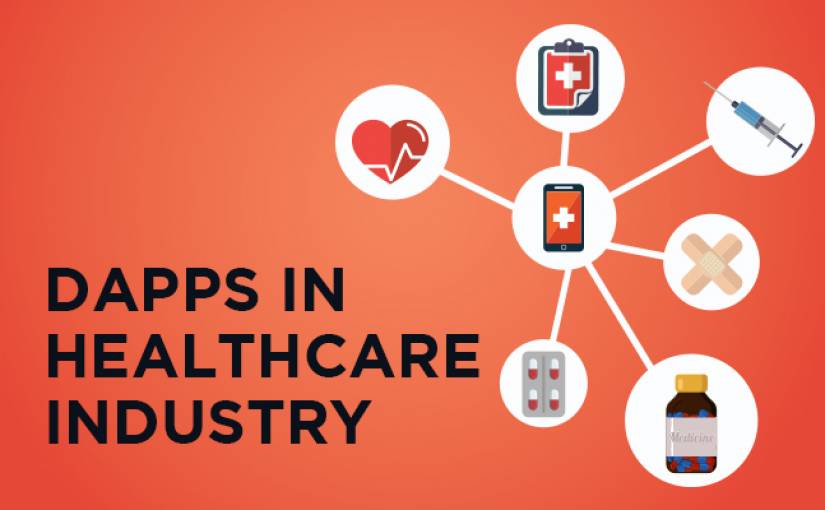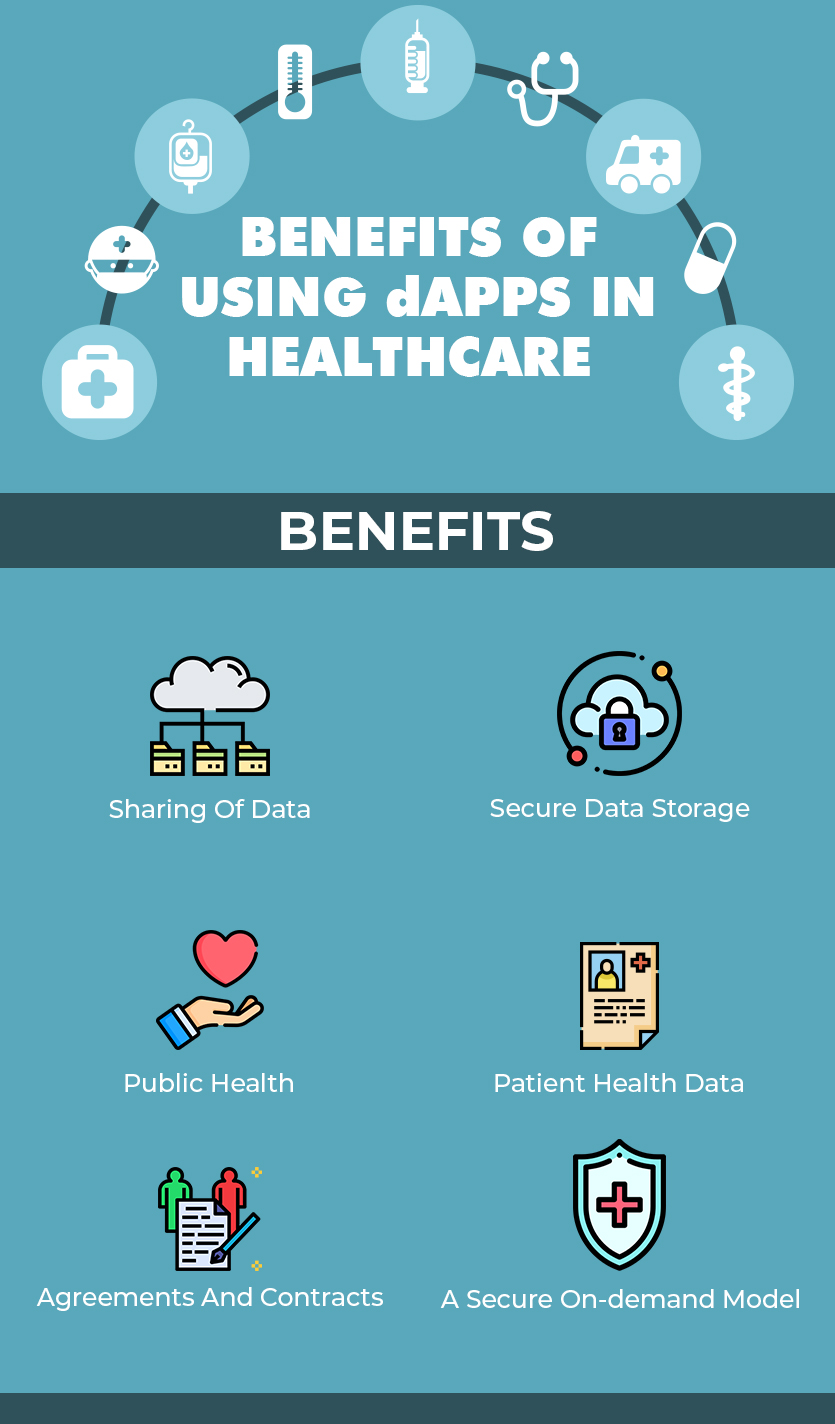From time to time, technology will come along that can be counted on to disrupt many industries. Blockchain is one such technology. Blockchain has started to make inroads into many business sectors. Blockchain will bring only thoughts of cryptocurrencies to many people. dApp development will help the healthcare industry.
However, technology has invaded industries as varied as healthcare and transportation. The dApp is one product that uses blockchain technology. These are applications or programs that run without centralized control. A central entity controls all applications. Blockchain technology is what facilitates the creation of dApps, so why does healthcare need blockchain technology?
What is blockchain technology?
It is not a technology that is used only in cryptocurrency transactions. The Blockchain is an open-source technology. In this technology, transactions get recorded on a decentralized ledger. Transactions get spread across the chain. There are no centralized agencies which control the operations. This technology cuts out the need for a middle man. Alternatively, it uses consensus from all involved parties to validate a transaction.
It is almost impossible for someone to make a transaction without the other entities knowing about it. It allows total transparency of all transactions. Though initially, people use this technology for transactions of cryptocurrencies, many industries are looking at ways to adopt this technology. There are many advantages of using this technology, especially where there is an exchange of data between many people.
Advantages of blockchain technology.
Before we see how Blockchain helps the healthcare industry, we should look at the benefits of using this technology. Any technology may get used if it adds value to the existing system. Let us see how blockchain technology is beneficial. The first and most significant advantage of Blockchain is that there is no central authority to validate transactions. Every transaction gets distributed to all the members of a chain.
Hence there is no way any tampering can happen. The fact that every transaction gets accepted by consensus will prevent any fraud. Every transaction is recorded and validated by everyone. It means that there is total transparency in the system. It improves trust in the system. Every member of the group can see the details of every transaction. In earlier systems, the data was stored in a centralized location.
In Blockchain, it gets spread among the various servers in the system. It makes it almost impossible for anyone to enter the system and steal the data. There is no central data store for hackers to target. As there is no central agency checking or approving each transaction, the cost of transactions become much less. It results in a considerable saving of money. The system itself takes care of the job. It also saves time.
- The Blockchain is a system that checks and approves the transactions
- As there is no single agency supporting the transactions, there is no way tampering can take place. All purchases need the consensus of all members.
- There is total transparency and trust because everyone can see all the transactions.
- There is more trust as everything is out in the open for everyone to see
- There is no centralized data storage for hackers to target.
- Money and time savings as there is no need to wait for someone to approve the transactions.
What ails the healthcare industry?
Before we see how Blockchain can play an essential role in the healthcare industry, we must look at the problems that the healthcare industry faces. There are many issues concerning sharing of medical information, treatment of patients, and distribution of medicines which can use the blockchain technology. One of the primary reasons for the theft of data from EMR (electronic medical records) of patients is that they are all stored in a centralized location.
It makes it easy for any hacker to access the data and use it for illegal purposes. Another problem with the medical record of patients is the delay in getting the data. The patient may have undergone treatment in one facility. If another health organization wants these data, they have to wait to get it. It may take longer if these facilities are located in locations far apart.
There is always difficulty in compiling the medical details from various sources. It may be possible to integrate the medical records from wearable devices of a patient with other data. But it certainly is not easy. Today more and more people are using wearable devices to record body activities.
- Theft of EMR is rampant as data gets stored in one location
- Hackers need only to open one storage device to get access to all data. These hackers sell these medical data for money.
- Sending data from one health organization to another can take a lot of time.
- Compiling of medical records from different sources is difficult.
- Integration of data from wearable devices with other medical records is a lengthy process.
Using Blockchain in the healthcare industry.
While Blockchain will help solve the above problems, it also finds a use for many purposes in the healthcare industry. Let us first see how Blockchain helps to solve the above issues. The first advantage of Blockchain is that it is fully decentralized. The system does not store any data in centralized storage devices. The data is available in a distributed manner across the whole network. There is no way hackers can target one source and get all the information.
When the data gets distributed across the whole chain, it is easy to access the data. The patient can own the data and decide who has access to the data. It means that when the patient goes to a different healthy facility, even in a different country, he or she can show the data to the new doctor. There is no time delay or the need to wait for someone to share the data.
Blockchain helps to merge the data from wearables to be integrated with other medical records available. Users will generate IoT data which they can consolidate with other healthcare organization data. Blockchain can help to secure IoT data with the utmost ease. Apart from the above, the main advantage is the formation of dApp, which are very helpful in the healthcare industry. Let us see how dApp can play a significant role in the industry. Before that, we need to look at what is a dApp.
What are dApps?
dApp stands for Decentralized Application. It is a web application meant for sharing of information between the users. Unlike other apps, there is no central ownership or managing body. All the users of the app maintain the app. Any new addition or change is made through mutual consent. A copy of the app gets stored in the computers of all the users. It doesn’t matter how many people are there in the network.
Bitcoin is probably the first dApp which runs on the Blockchain. It is a dApp for financial transactions. There is no central financial institution controlling the transactions. Each person adds an entry to the ledger.
Healthcare and dApps.
Apart from helping in financial transactions, dApps have been useful in many other industries. But healthcare is an industry which can get a lot of help from this technology. Let us see how the healthcare industry can use dApps.
Sharing of data.
It is probably the best use for dApps in the healthcare industry. When a patient is undergoing treatment, the details get entered in the app. dApps can connect the pieces of information in a shared network. It means that the treatment detail will be available at any time if the patient is visiting another hospital for treatment.
Another benefit is that such exchanges can help in patients getting better treatment. Sometimes patients of similar symptoms can be treated with different medication. If the data is updated, doctors can know which treatment was more beneficial and start using that medication.
Secure data storage.
It is another important use of dApps in the healthcare industry. The dApp can store the data and spread it across all members of the group. It means that there is no central storage server which hackers can target.
Hospitals store a considerable amount of data on secure servers. However, these are all vulnerable to attacks by hackers who will steal the personal data of patients. Having the data spread across an app will frustrate the hackers as there will be no target for them.
Public Health.
If there is a dApp which gets shared between various health practitioners and organizations, they can share information about an epidemic. It will help in treating the epidemic faster. Everyone in the network can add their knowledge about different treatment methods. It is right in the case of research too. If the research details get shared in a dApp, this can help different researchers involved in similar studies. They will know the results of various trails which have been conducted by their colleagues.
An important fact here is that all the users in the dApp verify every entry. There is no way to make a wrong entry can. Nobody can claim ownership wrongly as every entry has to be authenticated by mutual consent. The study is safe, and everyone who has contributed will get his or her credit.
Patient Health data.
Instead of storing the health details of patients in a centralized electronic health record, they can store in a dApp which is owned and controlled by them. They can decide who can view the app. Patients cannot access EHR now. In a dApp, the patients can integrate their medical details from wearable devices. They can also use other tools and include that data in the medical records. It will help the doctors to give a complete picture of the patients’ health.
Agreements and contracts.
It is a very time-consuming process getting the family members to sign the deal when someone has to undergo surgery. There are forms to be completed and signature affixed. These have to be sent to a centralized authority for approval. In the case of a dApp, the patients’ relatives and the hospital can manage this without any central authority. It is possible because the others in the group authenticate every entry. It saves a lot of time.
A secure on-demand model.
The on-demand service app has made its presence felt in the healthcare industry. There are apps which help in the supply of medicines. There are also apps which help you get a doctor when you want. But there was no secure app for this purpose. dApps are the solution. They can help in a very secure network of doctors and medical suppliers. If there is a problem, it is straightforward to find out where it has happened and correct it.
As all the users of the app have to authenticate, any data entered is immediately known to all the people concerned.
- Doctors treating patients who got treatment elsewhere can have instant access to patient’s records.
- Doctors can arrive at the best cure for a condition as treatment methods for similar symptoms are shared.
- Patient data is very secure as there is no central storage server for hackers to target.
- Epidemics can be treated quickly as information about treatment is readily available on the dApp.
- Researches researching similar diseases can share information and have access to details about various trials and results.
- Researchers are safe when sharing information as every entry needs authentication. Nobody can make the wrong claims.
- Patients can integrate all medical records in a dApp which they have access and can control. It is better than EHR.
- You can integrate medical results from wearable devices and other sources in one dApp.
- The signing of agreements and contracts are fast and secure.
- On-demand services become safer as mistakes can be immediately located and corrected.
Obstacles and Difficulties in Using Blockchain Technology.
Different regions have different medical guidelines. In a blockchain network, nobody knows whether everyone is following the directions correctly. It is because there is no central authority controlling the information. Another difficulty that occurs when storing medical data is storage capacity. Each user generates a considerable amount of data. It is much more than what can get stored in a blockchain because of the size restrictions of the block.
The time taken for data to be loaded on to the Blockchain is another matter. The process is prolonged. It is because of the number of consents that are required before it can get recorded. There is a need to find a better system than the proof-of-work method. Data cannot be changed once it gets entered in the Blockchain. It adds to the security of the data because no one can change it. But this also makes it impossible to scale the data.
Conclusion
The technology is still in its nascent state. There are many difficulties in using blockchain technology in the healthcare industries. There are unclear areas concerning data privacy. There is doubt about who should get access and who shouldn’t. The cost of technology is another obstacle to using it very widely. The main problem, however, would be to convince the various parties to adopt the technology and prove that it is useful and safer than present systems.
The fact that it keeps patients’ data safe and gives them control should be enough reason to push forward this technology.




















